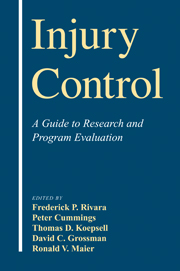Book contents
- Frontmatter
- Contents
- List of Contributors
- 1 An Overview of Injury Research
- 2 Classifying and Counting Injury
- 3 Measurement of Injury Severity and Co-morbidity
- 4 Data Linkages and Using Administrative and Secondary Databases
- 5 Rates, Rate Denominators, and Rate Comparisons
- 6 Data Collection Methods
- 7 Selecting a Study Design for Injury Research
- 8 Qualitative Methods in Injury Research
- 9 Randomized Trials
- 10 Cohort Studies in Injury Research
- 11 Case–Control Studies in Injury Research
- 12 Ecologic Studies
- 13 Case Series and Trauma Registries
- 14 Systematic Reviews of Injury Studies
- 15 Evaluating an Injury Intervention or Program
- 16 The Development of Clinical Decision Rules for Injury Care
- 17 Trauma Performance Improvement
- 18 Measuring Disability and Quality of Life Postinjury
- 19 Economic Evaluation of Injury Control
- 20 Ethical Issues
- Index
14 - Systematic Reviews of Injury Studies
Published online by Cambridge University Press: 16 October 2009
- Frontmatter
- Contents
- List of Contributors
- 1 An Overview of Injury Research
- 2 Classifying and Counting Injury
- 3 Measurement of Injury Severity and Co-morbidity
- 4 Data Linkages and Using Administrative and Secondary Databases
- 5 Rates, Rate Denominators, and Rate Comparisons
- 6 Data Collection Methods
- 7 Selecting a Study Design for Injury Research
- 8 Qualitative Methods in Injury Research
- 9 Randomized Trials
- 10 Cohort Studies in Injury Research
- 11 Case–Control Studies in Injury Research
- 12 Ecologic Studies
- 13 Case Series and Trauma Registries
- 14 Systematic Reviews of Injury Studies
- 15 Evaluating an Injury Intervention or Program
- 16 The Development of Clinical Decision Rules for Injury Care
- 17 Trauma Performance Improvement
- 18 Measuring Disability and Quality of Life Postinjury
- 19 Economic Evaluation of Injury Control
- 20 Ethical Issues
- Index
Summary
Introduction
The identification of effective strategies for the prevention, treatment, and rehabilitation of injury is essential, and the importance of taking evidence into account is increasingly recognized. However, sifting through the available research is a vast undertaking. Systematic reviews, through an evaluative process, identify and synthesize research, and present it in a manageable, accessible format for health care professionals, researchers, service planners, and consumers.
What is a Systematic Review?
Asystematic review is a summary of the best available evidence that addresses a sharply defined question (Sackett and Haynes, 1992). Conducting a review is a structured process involving several steps:
• a careful formulation of the question
• a comprehensive data search
• an unbiased selection and abstraction process
• a critical appraisal of data
• synthesis of data.
It is now recognized that the same scientific principles that apply to conducting original research should apply to reviewing research (Chalmers, 1995). Asystematic review seeks to draw together the totality of evidence using rigorously applied scientific criteria.
Systematic reviews should not be mistaken for meta-analyses. Meta-analysis is a quantitative method for combining and summarizing the results of different studies, which may or may not be employed in a systematic review.
Why do a Systematic Review?
Reducing Selection Bias
A systematic review of the literature aims to reduce the likelihood of biased conclusions. Such bias may come from several sources. A language bias can be introduced if only studies published in English are included. For example, authors of studies conducted in German speaking Europe are more likely (odds ratio = 3.75; 95% confidence interval 1.25–11.3) to publish statistically significant findings in English language journals than in German language journals (Egger et al., 1997a).
Keywords
- Type
- Chapter
- Information
- Injury ControlA Guide to Research and Program Evaluation, pp. 183 - 195Publisher: Cambridge University PressPrint publication year: 2000

